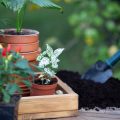1. Choosing the Right Tools for Your Garden
Before diving into maintaining your garden tools, it’s important to start with the right ones. Selecting high-quality, durable tools that match your gardening needs and your local climate can make a huge difference in how well they perform—and how long they last.
Understanding Your Gardening Needs
Every gardener has different goals, whether its growing vegetables, tending to flower beds, or maintaining a lush lawn. Knowing what tasks you’ll be doing most often will help you choose tools that are both practical and necessary. Here are a few common gardening activities and the essential tools for each:
| Gardening Task | Essential Tools |
|---|---|
| Planting & Weeding | Hand trowel, weeder, gloves |
| Pruning & Trimming | Pruners, loppers, hedge shears |
| Lawn Care | Lawn mower, edger, rake |
| Soil Preparation | Spade, hoe, garden fork |
| Irrigation & Watering | Garden hose, watering can, sprinkler system |
Selecting Tools Based on U.S. Climate Zones
The United States includes a wide range of climate zones—from hot and humid in the South to cold and snowy in the North. These conditions affect tool performance and maintenance needs. Consider the following when choosing tools for your region:
| Climate Zone | Recommended Tool Features |
|---|---|
| Hot & Humid (e.g., Florida) | Rust-resistant materials like stainless steel or fiberglass handles; avoid wooden handles prone to mildew. |
| Cold & Snowy (e.g., Minnesota) | Strong metal components that resist brittleness; ergonomic grips for use with gloves. |
| Dry & Arid (e.g., Arizona) | UV-resistant plastic or coated metals to prevent cracking; insulated grips to handle heat. |
| Mild & Coastal (e.g., Pacific Northwest) | Mildew-resistant materials; non-slip handles suitable for damp conditions. |
Tip:
If youre unsure about your local climate zone, check the USDA Plant Hardiness Zone Map online. It can also help guide what plants and tools are best suited for your area.
Investing in Quality Over Quantity
While it might be tempting to buy a full set of cheap tools, investing in fewer high-quality pieces will save you money in the long run. Look for tools with solid construction, comfortable grips, and good warranties. Brands known for durability in the U.S. include Fiskars, Corona, and True Temper.
Quick Checklist Before Buying:
- Material: Is it made from rust-resistant metal or durable plastic?
- Comfort: Does it have padded or ergonomic handles?
- Size: Is it appropriately sized for your strength and height?
- Usefulness: Will you use this tool regularly based on your gardening style?
- Maintenance Needs: Can it be easily cleaned and stored?
Selecting the right tools from the start lays a solid foundation for long-term care and maintenance. Next up: how to properly clean your tools after each use so they stay sharp and rust-free.
2. Cleaning Your Tools After Each Use
Keeping your garden tools clean after every use is one of the simplest yet most effective ways to make them last longer. It helps prevent rust, stops the spread of plant diseases, and keeps your tools working like new. The good news? You don’t need fancy products—basic household items will do the trick.
Why Regular Cleaning Matters
Every time you use your garden tools, they come into contact with soil, moisture, sap, and potentially harmful bacteria or fungi. If left uncleaned, these can lead to:
- Rust: Moisture left on metal surfaces causes oxidation over time.
- Disease Transmission: Pathogens from one plant can easily spread to another through dirty tools.
- Degradation: Dirt and plant residue dull blades and weaken tool joints.
Simple Cleaning Supplies You Probably Already Have
You dont need specialized cleaners for everyday maintenance. Here are some common household items that work well:
| Item | Purpose | How to Use |
|---|---|---|
| Warm Soapy Water | General cleaning | Use a sponge or brush to scrub off dirt and debris |
| White Vinegar | Rust prevention and disinfecting | Spray on metal parts or soak for 15–30 minutes before rinsing |
| Baking Soda | Mild abrasive for tough grime | Make a paste with water and scrub using an old toothbrush |
| Rubbing Alcohol (Isopropyl) | Sterilizing blades | Wipe blades with a cloth dampened in alcohol after pruning diseased plants |
A Quick Step-by-Step Routine
- Rinse off debris: Use a hose or bucket of water to remove loose soil and plant matter.
- Scrub: Use warm soapy water and a stiff brush to clean all surfaces thoroughly.
- Treat rust spots: Apply white vinegar or baking soda paste as needed.
- Sterilize if necessary: Wipe down cutting tools with rubbing alcohol if youve been trimming sick plants.
- Dry completely: Always dry your tools with a towel or let them air dry before storing to prevent rust.
Pro Tip: Create a Cleaning Station in Your Garage or Shed
If you have space, set up a small area dedicated to tool cleaning. Keep a bucket of soapy water, old rags, and a wire brush nearby so it’s easy to clean up right after gardening. Making it convenient increases the chances youll stick to this good habit!
The few minutes spent cleaning after each session go a long way in protecting your investment in quality garden tools—and in keeping your plants healthy season after season.

3. Sharpening and Oiling for Peak Performance
Keeping your garden tools sharp and properly oiled isn’t just about making yard work easier—it’s also key to extending the life of your equipment. Dull blades require more effort to use and can damage plants, while unlubricated moving parts can rust or seize up over time. With a little regular care, you can keep your tools working smoothly season after season.
Sharpening Garden Tools the Right Way
Sharp blades make cleaner cuts, which helps plants heal faster and reduces strain on your hands and wrists. Here’s how to sharpen common garden tools:
| Tool | Recommended Sharpening Method | How Often |
|---|---|---|
| Pruners & Shears | Use a sharpening stone or diamond file; follow the blades angle | Every few uses or when cutting becomes difficult |
| Loppers | Use a flat file on the beveled edge only; avoid the flat side | Once a month during heavy use seasons |
| Shovels & Hoes | A metal file works best; sharpen the leading edge at a 45-degree angle | Two to three times per season, more if used frequently |
Tips for Safe Sharpening
- Always wear gloves and safety glasses.
- Secure the tool in a vise or clamp it to a workbench for stability.
- File in one direction—don’t saw back and forth.
- Wipe off metal filings with a rag before storing.
Why Oiling Matters
Oiling your garden tools prevents rust, reduces friction between moving parts, and keeps everything operating smoothly. It’s especially important for tools with joints, springs, or screws like pruners and hedge shears.
How to Oil Your Tools
- Clean First: Wipe down the tool with a dry cloth to remove dirt and moisture.
- Select Your Oil: Use light machine oil, household oil (like 3-in-1), or even vegetable oil for an eco-friendly option.
- Apply Sparingly: Put a few drops on joints, blades, and any metal surfaces prone to rust.
- Wipe Off Excess: A light coating is all you need—too much oil can attract dirt.
Quick Tip:
A bucket of sand mixed with oil can double as a cleaning and maintenance station. Just plunge your tools into the sand after each use—it helps clean off debris while lightly oiling the metal.
Taking the time to sharpen and oil your garden tools not only improves performance but also saves you money in the long run by avoiding unnecessary replacements. Keep this routine going regularly, and your tools will be ready whenever you need them.
4. Proper Storage Solutions Across Seasons
Keeping your garden tools in good shape all year round starts with proper storage. Whether youre dealing with sweltering summers, freezing winters, or rainy springs, how and where you store your tools can make a big difference in their longevity.
Choosing the Right Storage Location
The best place to store garden tools is usually a shed or garage. These spaces offer protection from the elements and can be organized to keep tools off the ground and away from moisture.
Shed vs. Garage: Pros and Cons
| Storage Option | Pros | Cons |
|---|---|---|
| Shed | Dedicated space for garden tools; easy outdoor access | May need extra insulation for winter protection |
| Garage | Better temperature control; more secure | May compete with other household storage needs |
Seasonal Storage Tips
Spring and Summer
- Keep tools dry by storing them on wall hooks or pegboards.
- Use silica gel packets or moisture absorbers to prevent rust.
- Avoid leaving tools outdoors overnight.
Fall
- Clean off any mud or plant residue before storing.
- Inspect handles for cracks and apply wood oil if needed.
- Organize tools by type to make them easy to find next season.
Winter
- Store metal tools in a dry, enclosed space to avoid freezing damage.
- Add a light coat of mineral oil to blades to prevent rust.
- Keep long-handled tools upright or hang them to prevent warping.
Pest Prevention Tips
- Avoid storing tools directly on the floor where rodents may reach them.
- Seal any openings in sheds or garages to keep pests out.
- Use airtight containers for smaller items like gloves or hand tools.
With smart storage habits tailored to each season, your garden tools will stay in top condition and ready for action whenever you need them.
5. Routine Inspections and Repairs
To keep your garden tools in top shape for years to come, its important to inspect them regularly and fix any issues before they get worse. A simple check-up every few weeks can save you money and prevent frustrating breakdowns right when you need your tools the most.
Spotting Early Signs of Wear and Tear
The first step is knowing what to look for. Catching small problems early helps avoid bigger damage later on. Here are some common signs:
| Tool Part | Signs of Wear |
|---|---|
| Handles (wood or fiberglass) | Cracks, splinters, looseness |
| Blades (pruners, shears, shovels) | Dull edges, rust spots, chips |
| Nuts & Bolts | Rust, loosening, missing parts |
| Moving Joints (hinges or springs) | Squeaking, stiffness, wobbling |
Replacing Damaged Parts
If a part is beyond repair—like a cracked handle or a bent blade—it’s often more cost-effective to replace just that part rather than buying a whole new tool. Many hardware stores carry replacement parts for common tools like pruners, loppers, or hose nozzles. Look for these parts online or from the original manufacturer.
Quick Tip:
If youre replacing wooden handles, soak the new handle in linseed oil overnight before installing. This adds protection against moisture and rot.
Making Basic Repairs at Home
You don’t need fancy equipment to make basic repairs—just a few hand tools and some know-how:
- Tighten loose screws and bolts: Use a screwdriver or wrench to firm up any loose connections.
- Smooth out rough handles: Sand down splinters or rough patches with medium-grit sandpaper.
- Lubricate moving parts: Apply a few drops of machine oil to hinges and springs for smoother action.
- Straighten bent metal: Carefully use pliers or a rubber mallet to reshape minor bends in blades or tines.
A Handy Repair Kit Might Include:
- Screwdrivers (flathead and Phillips)
- Pliers and adjustable wrench
- Sandpaper (medium and fine grit)
- Lubricating oil (like 3-in-One)
- Eraser pad or wire brush for rust removal
The key is consistency—check your tools regularly and fix small issues before they become big ones. With just a little effort, your garden tools will stay dependable season after season.


